Google Shopping Ads cost depends on the industry, competition, and platform. On average, you may spend $0.66 per click. Learn the typical costs and how to create cost-efficient campaigns for the highest ROI possible.
Here, you’ll find:
- What’s the typical Google Shopping Ads cost?
- How does the cost of Google Shopping Ads compare with other options?
- Expert tips for optimizing your Google Shopping Ads cost per click
- How will future trends affect Google Shopping Ads costs?
Google Shopping Ads are a fantastic way to promote your products. They command clicks on Google Search by appearing at the very top of the search engine results page (SERPs).
However, like all pay-per-click (PPC) platforms, it’s important to keep on top of your costs. Otherwise, you may burn through your Google Shopping Ads budget sooner than you’d want.
In this article, we’ll discuss Google Shopping Ad costs, benchmarks, and the amount you can expect to spend. We’ll also share some of our top tips for keeping your cost per click as low as possible while ensuring high conversion rates.
Want to get started on Google Shopping Ads? Check out our guide to setting up your first shopping campaign!
What’s the typical Google Shopping Ads cost?
From our ecommerce client data, the average cost per click (CPC) for Google Shopping Ads can range between $0.46 – $1.20. However, this CPC can be higher or lower depending on the industry you’re in.
For example, the average CPC can be as low as $0.34 in the arts and music category, and as high as $1.39 in the office and business needs category.
Why such a big difference in cost?
- There’s more competition in the office and business needs category, which drives up the average CPC.
- Office and business products typically have a higher profit margin, which means companies can afford to place higher bids.
- Arts and music searches are generally informational in intent. For example, someone will want to do a lot of research before investing in a guitar. Then, someone wanting to buy a laptop stand for the office will likely want to buy right away. These searches are more targeted, and customers are closer to purchasing, so companies are willing to spend more.
While cost per click is a vital metric and determines the bulk of the cost of your Google Shopping Ads campaign, it’s important to consider other costs.
These costs include:
- Agency fees: If you use a digital marketing agency, consultant, or freelancer to manage your Google Shopping Ads campaigns, you must include their costs. This is usually a flat fee or a percentage of your ad spend.
- Third-party tools: You may use tools and platforms to manage your product listings on your behalf. For example, if you use Shopify, the Clever Ads app will automate your Performance Max (formerly Smart Shopping) ads using artificial intelligence (AI).
- Your time: If you manage your campaigns in-house, you’ll spend time updating your product data feed, optimizing your listings, and monitoring results. So, consider the cost of the hours spent on this work.
Remember that a high cost isn’t necessarily a bad thing.
“In our experience, each industry has its own cost metrics — not just CPC, but click-through rate (CTR), cost per acquisition (CPA), and average conversion rate, says Sam Yadegar, CEO of HawkSEM. “My advice would be to not only understand these metrics along with the competitive landscape, but to take a return on ad spend (ROAS) approach when using Google Shopping Ads. While the CPCs may be high for a specific category, this may indicate that you can make significant revenue.”
How does the cost of Google Shopping Ads compare with other options?
Now we have a good idea of Google Shopping Ad costs, how does this compare to other PPC platforms? Let’s take a look.
- Google Shopping Ads vs. Google Search Ads
- Google Shopping Ads vs. Bing Shopping Ads
- Google Shopping Ads vs. paid social
- Google Shopping Ads vs. Google Display Ads
Google Shopping Ads vs. Google Search Ads
Google Search Ads, also known as text ads or search campaigns, can be used by a wider range of businesses than Google Shopping Ads. As a result, there’s a lot more competition, which can drive up the cost.
The average CPC for Google Search Ads is $4.22 — 500%+ more than Shopping Ads. Although again, the specific cost depends on the industry you’re in.
Alex Adekola, CEO and Founder at 808Beats, is a fan of the benefits of Google Shopping Ads over Google Search Ads.
“Not only do they appear at the top of the search results, they enable detailed product data like images, price, and additional information like whether free shipping is available,” shares Adekola. “We’ve found Shopping Ads drive a 23% lower cost-per-conversion compared to Search Ads as a result.”
As an ecommerce business, there may be occasions where you opt to use a Search Ad over a Shopping Ad. You can even use both simultaneously, like electrical retailer Currys has done here:

For example, you can use Search Ads to target searchers looking for solutions to problems. If you sell environmental cleaning products, you can create ads focused on the search query “how to clean your kitchen sustainably.” This is a great way to introduce customers to your brand and gain traction in the SERPS.
Google Shopping Ads vs. Bing Shopping Ads
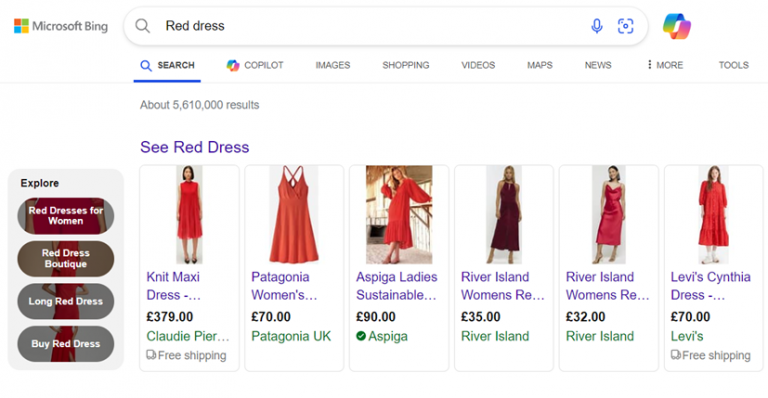
Bing offers its own version of Google’s Shopping Ads — Bing Shopping Ads, also known as Microsoft Advertising Shopping Campaigns.
Bing Shopping Ads have a lower cost per click than Google Shopping Ads, with the average cost per click coming in at $0.46 — 36% cheaper.
Why are Bing Shopping Ads cheaper on average? Less competition. Fewer companies use Bing Ads, meaning lower costs.
However, it’s interesting that the lowest-cost industries on Google Shopping Ads aren’t necessarily the cheapest on Bing Ads. Take, for example, the arts and music category, which is a staggering 149% more costly.
This is ultimately down to user demographics. For example, Bing searchers are typically older and more affluent than Google users, so they may have more time and money for hobbies and interests.
So Bing vs Google, which wins out? While Bing Shopping Ads is cheaper, this doesn’t automatically make it the better option. The winning solution depends on what you sell and who you sell it to.
Google Shopping Ads vs. paid social
The cost of paid social ads is harder to determine because it depends on the platform you use, and the ad formats available. For example, the average CPC of a TikTok ad can vary between $0.48 and $0.98, while the average Instagram CPC is $1.36.
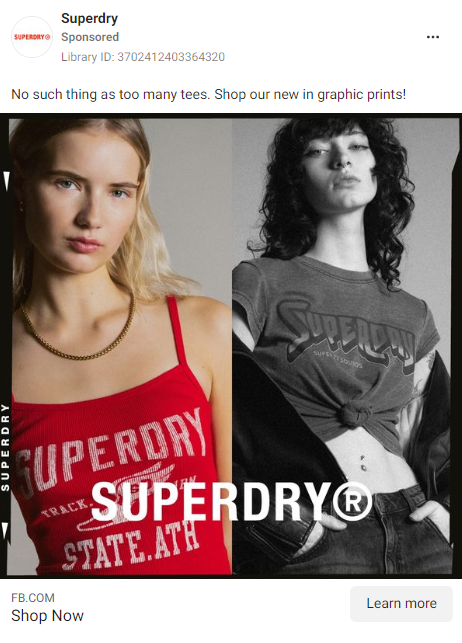
Why the variation? There are several factors to take into account:
- The popularity of the platform — for example, Facebook has a larger user base than Pinterest
- The demographics you target — if there is more competition, this will affect the cost of your ad
- What you sell — as a rule of thumb, the more expensive the product you sell, the higher the ad cost
- The ad format — some ad formats are more popular than others, which changes the cost
- The objective of the ad — adverts focusing on impressions are cheaper than those focusing on conversions
The benefit of paid social ads is that you can use them to target customers outside of Google — the average person spends 2 hours and 23 minutes on social media, after all!
Google Shopping Ads vs. Google Display Ads
Google Shopping Ads and Google Display Ads have a lot in common. They both use visuals to encourage people to click and convert. They’re also both more affordable than Google Search Ads, with Display Ads costing $0.63 per click on average.
However, Shopping and Display Ads serve different purposes. Google Shopping Ads target customers at the bottom of the sales funnel who are ready to buy. Google Display Ads raise brand awareness for customers at the top of the sales funnel.
The exception to the rule? Remarketing Display Ads. These adverts appear to customers who visited your online store before, encouraging them to come back and purchase the products they viewed.
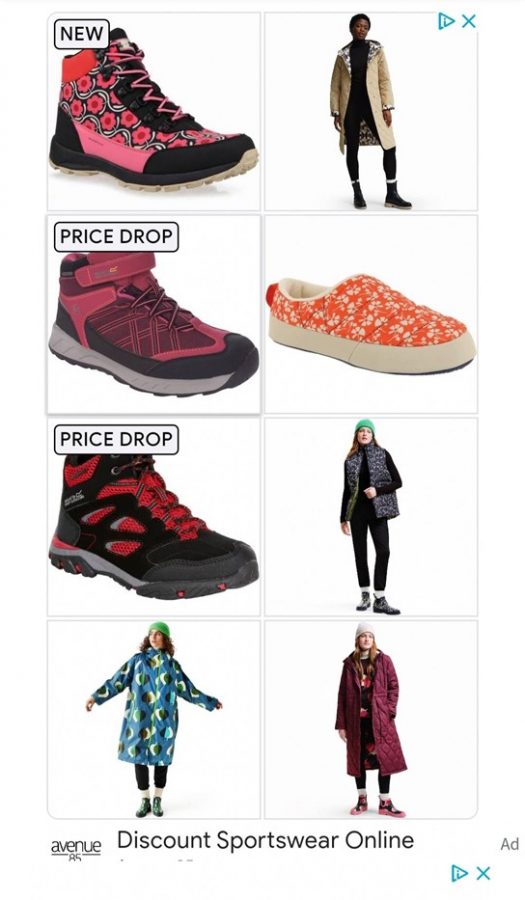
Remarketing Display Ads and Google Shopping Ads can work well together and lead to conversions. Use Shopping Ads to get potential customers to check out your website and if they don’t convert, use Remarketing Display Ads to remind them what they’re missing out on.
Expert tips for optimizing your Google Shopping Ads cost per click
While the average cost per click for Google Shopping Ads is predominantly determined by what you sell, there are things you can do to reduce your Google Shopping Ad costs. We asked our expert PPC team the best things to do to keep costs low.
- Structure your Google Shopping campaigns correctly
- Use negative keywords to eliminate wasted clicks
- Target your ads to focus on the right people
- Ensure your specific product pages offer a good user experience
- Monitor your results and optimize accordingly
Want to know more about optimizing your ads? Here are some more tips for making Google Shopping Ads work for you.
Structure your Google Shopping campaigns correctly
Before creating your Google Shopping Ad campaign, you must add your product information to Google Merchant Center. You can do this manually or through an ecommerce platform like Shopify or WooCommerce.
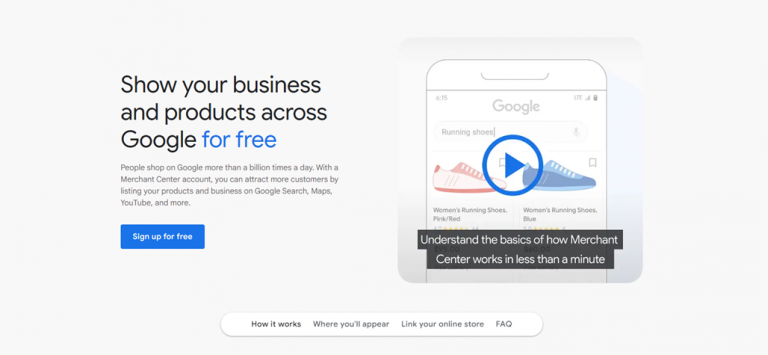
Structuring your products in your Google Merchant Center account makes it easier to manage and control your product listings — which can lower your cost per click.
Here are some ways to reduce CPC and improve ad performance:
- Make sure your product data is as complete and as accurate as possible. The more information you can provide, the more likely customers are to convert.
- Organize products into specific groups to set unique bids and create targeted ad campaigns. For example, if you sell dresses, group them into maxi dresses, midi dresses, and mini dresses.
- Custom labels can help you segment your products even more. For example, you can use them to indicate products that are on clearance or are best sellers.
Use negative keywords to eliminate wasted clicks
Negative keywords ensure your Google Shopping Ads show to the right people. They allow you to exclude unwanted search terms from triggering your Shopping Ads.
For example, if you sell luxury items, excluding certain search queries like “sale,” “bargain,” and “cheap,” can mean you don’t waste money targeting people who won’t buy your products.
Regularly adding new negative keywords can educe wasted ad spend and keep your cost per click low.
Target your ads to focus on the right people
There are other ways to target your Google Shopping Ads to ensure they appear in front of the right searchers.
Adam Palmer, Google Ads Leads at Imaginaire uses targeting to reduce wasteful spend.
“One of the most common mistakes is businesses casting their net too wide,” explains Palmer. “We implemented a fixed schedule for one of our clients to counteract wasteful spending in the early morning hours. This, alongside other tweaks, led to a 28% reduction in ad spend whilst maintaining conversion value.”
Other ways to target your Google Shopping Ads include:
- Demographic targeting by age, gender, location, income, and parental status
- Using affinity audiences to target customers with specific hobbies and interests
- Targeting by desktop or mobile device — with mobile device, you can even drill down to a specific operating system or phone type
Ensure your specific product pages offer a good user experience
Creating the perfect Google Shopping Ad is only part of the equation. It’s also important to ensure your product pages are easy to use, mobile-friendly, and provide potential customers with all the necessary information. This leads to increased conversions and a higher ROAS.
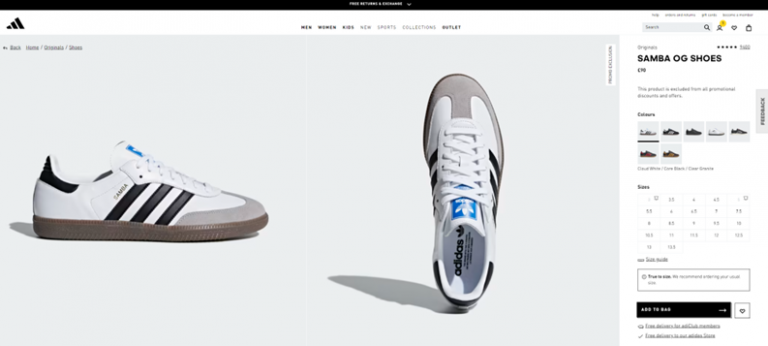
According to Baymard, only half of the top-grossing US and European ecommerce sites have a “decent” or “good” performance. This means there’s always room for improvement!
A solid product landing page can also increase your Quality Score, reducing your average cost per click for Google Shopping Ads.
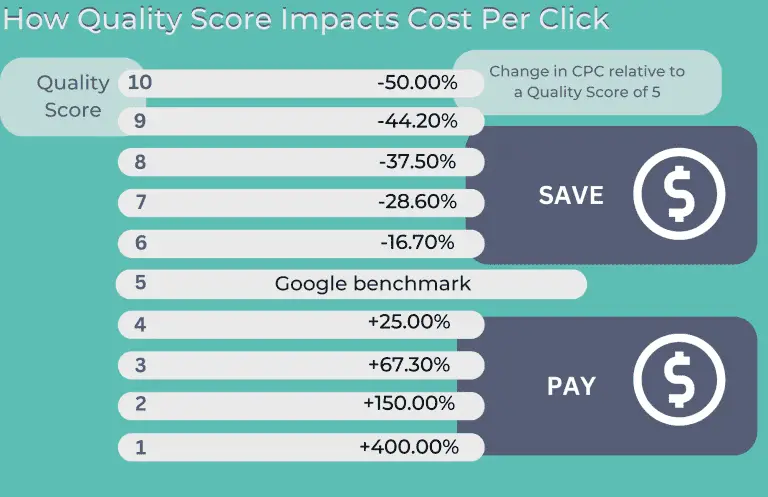
Increasing your Quality Score from 5 to 10 means you save money by paying 50% less per click.
Monitor your results and optimize accordingly
Monitor your Google Ads account and make tweaks to reduce costs.
How often should you review your campaigns? You should look at small campaigns once or twice a week, and larger, more complex campaigns once a day.
Here’s what we recommend to ensure your Google Shopping Ads campaigns are optimized for a lower CPC:
- Check impressions, clicks, and conversions for any sudden increases or decreases
- Identify high-performing products and allocate more daily budget to them
- Look for poorly performing titles and product images and amend them
- Check the product feed for errors
- Identify new opportunities and add relevant keywords to campaigns
- Add negative keywords to ensure effective targeting
Using tools can make it easier to monitor your Google Shopping Ads, especially if you have a lot of listings.
“We use ConversionIQ (CIQ) to granularly track every single step of the buyer journey, from first click to conversion”, says Yadegar. “This lets us see what aspects of a Google Shopping Ad are working, and where we can make changes to improve cost-effectiveness, meaning we can optimize towards a higher ROAS.
“An additional bonus is that CIQ provides more insight about the target audience — we can take that data and use it on another marketing channel (for example, SEO) to further scale while maintaining profitability.”
How will future trends affect Google Shopping Ads costs?
While it’s always tricky to predict the future, we’ve identified two key trends that may affect the cost of Google Shopping Ads in the upcoming years; AI and third-party cookies.
AI and automation
Google Ads is using AI to automate the advertising process, making it easier for users to create, manage, and optimize their ads.
For example, Google Shopping Ads users can take advantage of automated bidding strategies, which use AI to adjust bids to maximize the number of clicks and conversions received. These big strategies are sometimes referred to as Smart Bidding.
While AI and Smart Bidding can reduce Google Shopping Ad costs, they can also potentially increase them. An automated bidding strategy may prioritize conversions over cost, raising bids.
Third-party cookies
Google is on track to eliminate third-party cookies from Chrome in 2024. When this rollout is complete, all web browsers will no longer track third-party cookies.
While eliminating cookies is good news from a security and data protection perspective, this will likely make it harder to target customers with Google Shopping Ads. As a result, targeting accuracy may be less precise, which may drive up costs in Google Ads accounts.
However, Google is looking at ways to ensure Shopping Ads target the right people, for example, through Turtledove, which analyzes user behavior locally on their devices.
The takeaway
Google Shopping Ads is one of the more affordable ways to promote your business if you’re in the ecommerce industry. However, to ensure a cost-effective campaign, put the work in and stay one step ahead of the competition.
If you want to maximize Google Shopping Ads, our expert team can help. For example, we used Shopping Ads to help HomElectrical increase ROAS by 19%, which means increased revenue and improved brand awareness.
Want to see how we can do the same for your ecommerce store? Contact us today.



